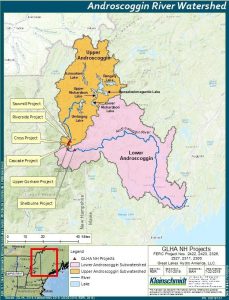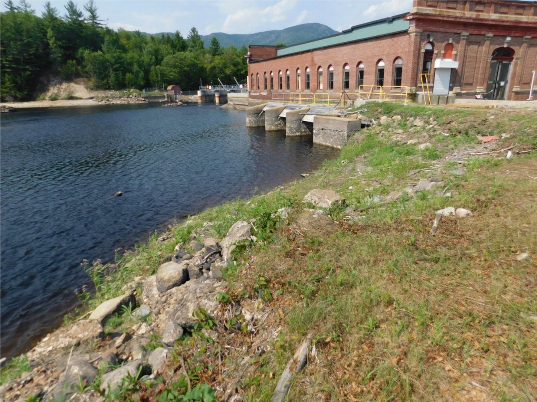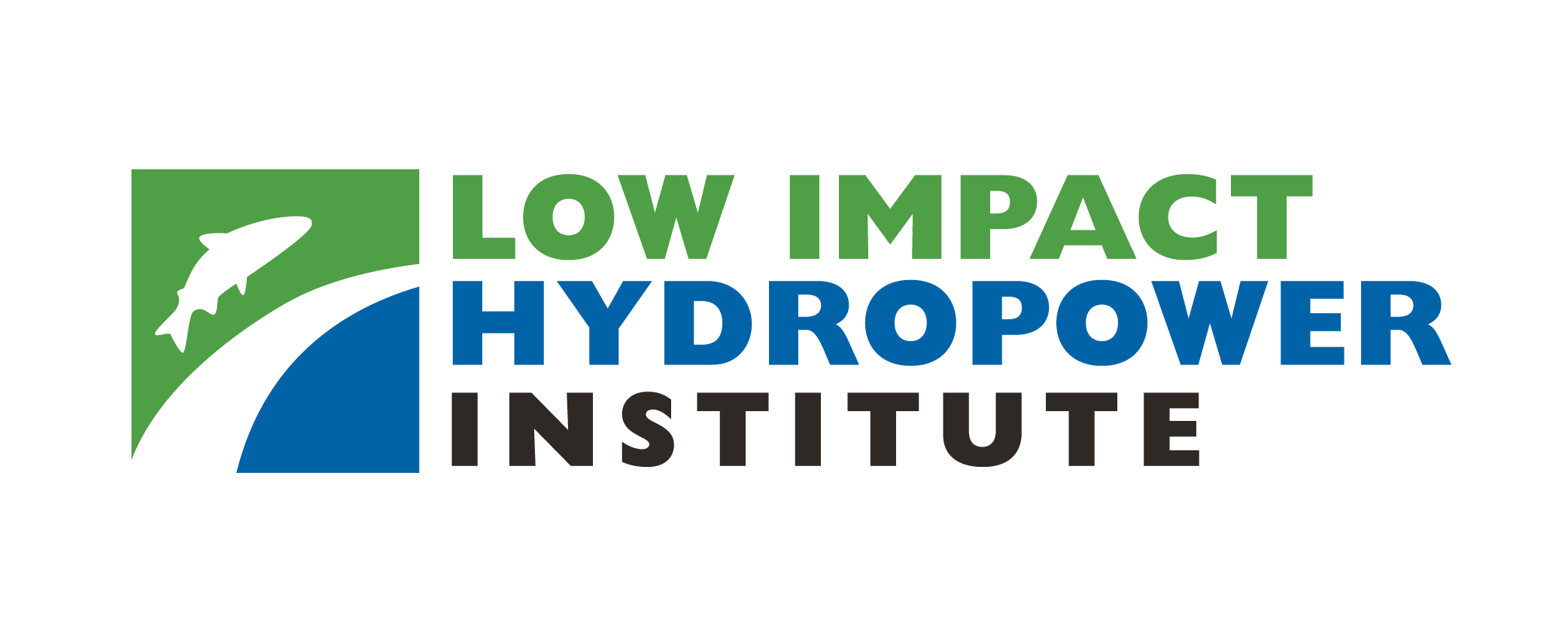Certificado LIHI #176 - Proyecto Shelburne, Nuevo Hampshire



| Nombre del proyecto | Shelburne |
| Certificado LIHI No. | 176 |
| Plazo del certificado LIHI | 31 de agosto de 2020 – 30 de agosto de 2030 |
| Dueño | Great Lakes Hydro America, LLC, una subsidiaria de Brookfield Renewable Energy Group |
| Estado | Nuevo Hampshire |
| Ubicación | Milla fluvial 127,6 – Río Androscoggin |
| Capacidad instalada | 3,72 MW |
| Generación media anual | 10.470 MWh |
| Tipo de instalación | Flujo de río |
| Comisión Federal de Comercio No. | Shelburne P-2300
Emitido en 1994, vence el 31/07/2024 |
El Proyecto Shelburne se ubica en el río Androscoggin, en el condado de Coos, al norte de Nuevo Hampshire. El río Androscoggin atraviesa los estados de Nuevo Hampshire y Maine. Se une al río Kennebec en la bahía Merrymeeting, en Maine, antes de desembocar en el golfo de Maine y posteriormente en el océano Atlántico. La cuenca del río Androscoggin alberga 19 proyectos hidroeléctricos ubicados a lo largo de sus 286 kilómetros de longitud.
El proyecto es el más aguas abajo de varios proyectos hidroeléctricos dentro de un alcance de 11 millas del río Androscoggin entre Berlín y Shelburne, New Hampshire, que incluye Alto Gorham (LIHI #175), Gorham (LIHI #153), Cascada (LIHI #188), Potencia cruzada (LIHI #174), y Aserradero (LIHI #173).
El proyecto incluye una presa Originalmente construido en 1903, central eléctrica, tres turbinas y equipos de transmisión.
La presa tiene 551 pies de largo con una altura máxima de 17,5 pies y está compuesta por:
- Secciones de presa sin desbordamiento que suman un total de 146 pies de longitud.
- Un barco de 171 pies de largo aliviadero con una sección de 83 pies de largo coronada por una torre de 9 pies de alto tableros de flash y una sección de 88 pies que contiene tres desechos de 25 pies de ancho puertas.
- Una compuerta de 27 pies de ancho adyacente a las compuertas de desechos, controlada por una compuerta de 19 pies de ancho.
- Un edificio de 17 pies de largo por 14 pies de ancho que alberga los controladores de la puerta ubicados en la isla adyacente al muro de la compuerta.
- Un muro de contención de hormigón de 95 pies de largo ubicado entre la compuerta y la central eléctrica.
La central eléctrica está construida con ladrillo y estructura de acero sobre nueve pilares de hormigón de 1,2 metros de ancho, cada uno integrado en la presa. El paramento aguas arriba de la central está a ras del paramento aguas arriba de la presa. La central eléctrica contiene una toma de 4,5 metros de profundidad por 34 metros de largo con rejillas para residuos con un espacio libre de 7,6 cm y tres pozos verticales. Turbinas Francis con una capacidad combinada de 3,72 MW.
El proyecto opera en un marco cuasi-de pasada El proyecto establece un régimen de caudal mínimo de 250 acres y embalsa un embalse de 250 acres. El embalse puede fluctuar en un rango de 6 pulgadas. El proyecto proporciona un caudal mínimo de 2 pies cúbicos por segundo (cfs) en el corto tramo desviado. Este régimen de caudal se desarrolló en colaboración con el Servicio de Pesca y Vida Silvestre de los Estados Unidos (USFWS) y el Departamento de Servicios Ambientales de New Hampshire (NHDES).
Las aguas dentro del alcance del proyecto se clasifican como de Clase B, aptas para la pesca, la recreación de contacto primario y el suministro de agua después del tratamiento. Dichas aguas están catalogadas como contaminadas debido a vertidos previos de varias fábricas de papel. Dadas las operaciones de pasada, es improbable que el proyecto afecte negativamente la calidad del agua.
El río Androscoggin no es accesible para diádromo Especies de peces en el alcance del proyecto. Especies como la sábalo americano, el arenque de lomo azul, la lubina rayada, la lamprea marina y el sábalo americano no están presentes en el área debido a las cascadas naturales río abajo: Lewiston y Rumford Falls. La anguila americana está presente en los tramos inferiores del río Androscoggin, aunque históricamente ninguna ha llegado a las secciones superiores del río. El área del proyecto sustenta el hábitat de la pesca de agua fría. El Departamento de Pesca y Caza de New Hampshire anualmente repobla truchas de arroyo, arcoíris y marrones río arriba de los proyectos. Las especies residentes del río incluyen el pez de río, la lubina de boca chica, el matalote blanco, el dace de hocico largo, el albur común, el albur de cola moteada y la perca amarilla. El paso río abajo puede ocurrir mediante el flujo del aliviadero, las liberaciones de compuertas de bajo nivel y el flujo de la toma de energía a través de las rejillas de basura. El proyecto no impide la finalización exitosa de los ciclos de vida de los peces residentes.
Los terrenos del proyecto se limitan al área ocupada por la infraestructura. Se desarrolló un plan de protección costera para establecer una zona de amortiguamiento de 76 metros desde la costa. El plan establece disposiciones sobre el uso del suelo y las normas de plantación y eliminación de vegetación dentro de dicha zona. El plan cumple con la Ley de Protección de Zonas Costeras de New Hampshire. Además, las operaciones de pasada del proyecto protegen las zonas costeras.
Entre las especies amenazadas o en peligro de extinción que podrían estar presentes en las inmediaciones del proyecto se incluyen el murciélago orejudo norteño, el lince canadiense, el murciélago de patas pequeñas oriental, el murciélago café chico, el murciélago tricolor, el águila calva, la reinita de Cabo Mayo, el picogrueso vespertino, el mirlo herrumbroso, el zorzal de bosque, la tortuga de bosque, la marta americana, el halcón peregrino y el chotacabras común. Entre las especies vegetales se incluyen la twayblade aurículada, la cicely dulce de montaña, la juncia de punta ovoide, la juncia parasol, la shinleaf rosada, la enramada de la virgen púrpura, la orquídea de hojas redondas, el helecho liso de acantilado, el arándano enano, el helecho de bosque fragante, la twayblade de hojas de corazón y la hierba de sauce de Hornemann.
Es poco probable que las especies de murciélagos incluidas en la lista se vean afectadas por las operaciones del proyecto, ya que generalmente no se realizan actividades de desmonte ni mantenimiento del corredor. Se realizan algunas tareas de remoción de vegetación y mantenimiento para garantizar la seguridad de la presa, pero dichas actividades se ajustan a la norma 4(d) del USFWS sobre la protección del hábitat de las especies de murciélagos. La mayoría de las demás especies incluidas en la lista se han observado en las inmediaciones del proyecto, pero las operaciones de pasada y los límites de fluctuación del embalse mitigan cualquier impacto sobre estas especies.
El área del proyecto no alberga ningún recurso histórico ni cultural conocido. Sin embargo, el proyecto opera bajo un Acuerdo Programático (AP) en consulta con la Oficina Estatal de Preservación Histórica. El AP establece disposiciones que detallan el monitoreo y la presentación de informes anuales sobre las actividades de reparación y mejora realizadas, así como las actividades programadas para el año siguiente.
Los recursos recreativos del proyecto incluyen señalización interpretativa que detalla la historia del proyecto. El acceso público es gratuito.
Estado de cumplimiento
El Certificado incluye las siguientes condiciones específicas de la instalación:
Condición 1: El Propietario de la instalación deberá informar a LIHI sobre el estado de la renovación de la licencia del Proyecto, incluyendo estudios, presentaciones ante la FERC, consultas con la agencia de recursos, prescripciones y recomendaciones, y comentarios de la agencia sobre los resultados de los estudios. LIHI se reserva el derecho de modificar el Certificado o las condiciones en función del resultado de la renovación de la licencia.
2025: No se identificaron cambios sustanciales ni problemas de cumplimiento. El proyecto se mantiene en cumplimiento según la revisión anual. Para la Condición 1, el proyecto proporcionó una actualización del estado y enlaces a los documentos de renovación de licencias. La FERC emitió su Evaluación Ambiental final el 7 de octubre de 2024 y el NHDES emitió una certificación de calidad del agua el 19 de septiembre de 2024.
2024: No se identificaron cambios sustanciales ni problemas de cumplimiento. El proyecto se mantiene en cumplimiento según la revisión anual. Para la Condición 1, el proyecto proporcionó una actualización del estado y enlaces a los documentos de renovación de licencias. La FERC emitió su borrador de Evaluación Ambiental el 23 de mayo de 2024.
2023: No se identificaron cambios sustanciales ni problemas de cumplimiento. El proyecto se mantiene en cumplimiento según la revisión anual. En cuanto a la Condición 1, el proyecto no reportó cambios en su estado.
2022: No se identificaron cambios sustanciales ni problemas de cumplimiento. El proyecto se mantiene en cumplimiento según la revisión anual. Para la Condición 1, el proyecto informó la presentación de la solicitud final de renovación de la licencia de la FERC el 29 de agosto de 2022.
2021: No se reportaron cambios ni problemas de cumplimiento. El proyecto se mantiene en cumplimiento según la revisión anual. Para la Condición 1, el proyecto informó la presentación del informe inicial del estudio de renovación de la licencia.
2020: La presentación de informes anuales para el Certificado actual aún no ha entrado en vigor.
Historial de certificaciones
1 de enero de 2022: El plazo del Certificado LIHI se ha extendido de acuerdo con la Revisión 2.05 del Manual de Certificación LIHI 2.ª Edición emitido el 1 de enero de 2022. Consulte la tabla de instalaciones anterior para conocer el nuevo plazo.
30 de noviembre de 2020: La decisión de certificar el Proyecto Shelburne quedó firme tras el cierre del plazo de apelaciones el 27 de noviembre de 2020, sin que se presentaran apelaciones. El plazo de la certificación es del 31 de agosto de 2020 al 30 de agosto de 2025. El certificado incluye la siguiente condición:
27 de octubre de 2020:El Instituto de Energía Hidroeléctrica de Bajo Impacto (LIHI) aprobó preliminarmente la Certificación de Bajo Impacto para los Proyectos Hidroeléctricos Sawmill, Cross Power, Upper Gorham y Shelburne, ubicados en el río Androscoggin, New Hampshire. Esta decisión es preliminar, a la espera del plazo de apelación de 30 días. Solo quienes comentaron sobre la solicitud inicial durante el plazo de 60 días pueden presentar una apelación. Dicha apelación debe incluir una explicación de por qué el Proyecto no cumple con los criterios del LIHI. Las solicitudes de apelación para uno o más de estos proyectos pueden enviarse por correo electrónico a comentarios@lowimpacthydro.org Con el asunto "Proyectos del río Androscoggin-NH", o por correo postal dirigido al Instituto de Energía Hidroeléctrica de Bajo Impacto, 329 Massachusetts Ave, Suite 6, Lexington, MA 02420. Todas las solicitudes se publicarán en el sitio web. El solicitante tendrá la oportunidad de responder, y cualquier respuesta también se publicará. Las solicitudes deben recibirse antes de las 5 p. m., hora del Este, del 27 de noviembre de 2020. La solicitud completa y el informe de revisión están disponibles a continuación. Si no se reciben solicitudes de apelación, el período de certificación para cada proyecto será del 31 de agosto de 2020 al 30 de agosto de 2025.
13 de agosto de 2020: El Instituto de Energía Hidroeléctrica de Bajo Impacto (LIHI) ha recibido una solicitud completa para la Certificación de Bajo Impacto de los Proyectos Hidroeléctricos Sawmill, Cross Power, Upper Gorham y Shelburne, ubicados en el río Androscoggin en New Hampshire. LIHI solicita comentarios públicos sobre esta solicitud. En concreto, nos interesa saber si considera que los Proyectos cumplen con los Criterios de Certificación de Bajo Impacto de LIHI, revisados en la 2.ª edición del Manual. La solicitud se encuentra a continuación. Los comentarios directamente relacionados con criterios específicos de LIHI (caudales, calidad del agua, paso de peces, etc.) serán de gran ayuda, pero se tendrán en cuenta todos los comentarios. Los comentarios pueden enviarse al Instituto por correo electrónico a comentarios@lowimpacthydro.org Con el asunto "Comentarios del Proyecto Androscoggin River-NH", o por correo postal dirigido al Instituto de Energía Hidroeléctrica de Bajo Impacto, 329 Massachusetts Avenue, Suite 6, Lexington, MA 02420. Los comentarios deben recibirse antes de las 17:00 h (hora del este) del 12 de octubre de 2020 para ser considerados. Todos los comentarios se publicarán en el sitio web y el solicitante tendrá la oportunidad de responder. Cualquier respuesta también se publicará.
Archivos de certificación
Certificación 2020
- Revisión de la certificación de proyectos de NH en Berlín 2020
- Solicitud de certificación de proyectos de Berlín NH 2020
